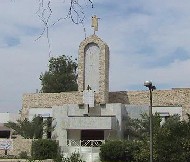The Tigris: A holy river
On the banks of the Tigris, dozens of Iraqis dressed in white gather to bathe in the river’s muddy waters in an ancient rite to purify both body and soul.

Every Sunday, the bathers make their way to the bridge that crosses the Tigris in Al-Qadisiyah quarter while a collection of local citizenry, foreigners and US soldiers look on.
The bathers are Mandeans – a Gnostic religion with about 20,000 followers living in southern Iraq and southwestern Iran.
They believe the cosmos is made up by two forces in conflict, the forces of light and darkness – it is from this conflict that the world came.
Tigris baptism
Baptism is central to the worship of the Mandeans, whose origins are unknown, but who consider themselves the latter-day disciples of the prophet Ibrahim (Abraham) and of Yahya (John the Baptist).
The newly born, the elderly in their final years of life, couples about to marry and the faithful seeking forgiveness for their sins must all pass through the ritual of baptism in the Tigris.
This Sunday an elderly priest married a young couple by anointing them with oil and water. The bride and groom both pronounced a series of promises in Aramaic, a semetic language related to Arabic and Hebrew.
 |
|
The Manda temple in Baghdad |
“Ahead of any important moment in our lives, the soul must be clean,” explains the master of ceremonies, Haldun Majid, whose long beard, white tunic and sandals give him an aura of religious authority.
For the Mandeans, the flowing water of rivers is central to their worship, and they will drink it even if it is contaminated. “We are never sick. Water is the secret of life and of purification,” one believer explains.
Going public
The Mandeans say that during the decades of Saddam Hussein’s government they were permitted to perform their rituals discreetly, but were the victims of many injustices.
Even today, they cannot carry out their rites as spelled out in their sacred book, the Ginza Rabba, or Great Treasure, an Aramaic text written in 1291 AD.
For one thing, the staring eyes of outsiders make them uncomfortable.
“Sometimes we prefer to hold our celebrations in a tank of rainwater that we have inside the temple to avoid the stares of people,” says priest Khayr Ala.
Upper class believers
Despite their humble appearance, most of the people taking their ritual dips in the Tigris are from upper class families in the capital, who have driven here in expensive cars to the temple.
The entrance to the temple is marked by two olive branches in the form of a cross, symbolising those used by John the Baptist to sprinkle holy water on the assembled crowds.
Also, the riverside ceremonies are sometimes interrupted by American soldiers, Ala says, noting that 33 people from his community died during the US-led invasion. “All of them innocent civilians.”